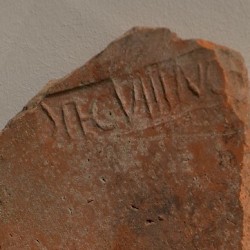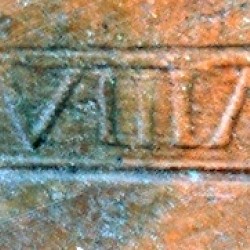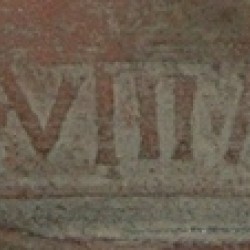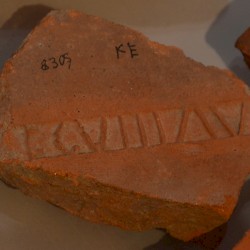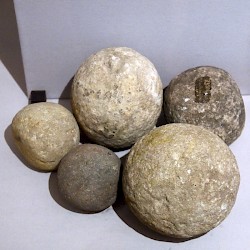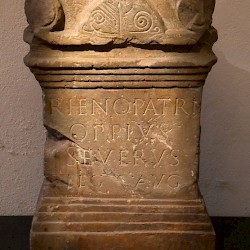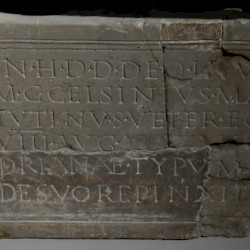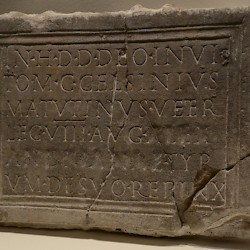Legio VIII Augusta
Legio VIII Augusta: one of the Roman legions. Its surname means "the legion of Augustus", but contains a pun on "august legion".
Origins
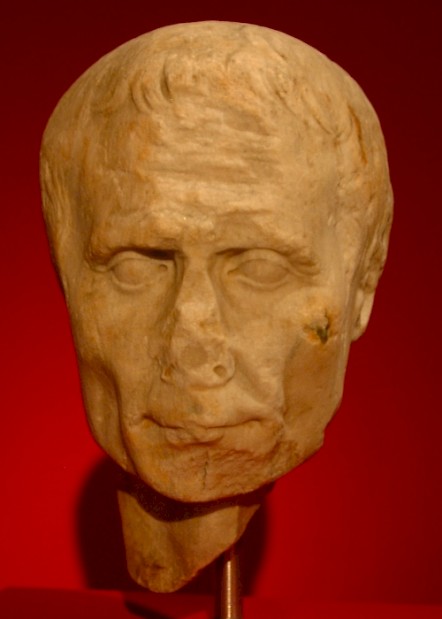
With the Seventh, Ninth and Tenth legions, the Eighth was among the oldest units in the imperial Roman army. They were with Julius Caesar when he invaded Gaul in 58 BCE. The Roman commander mentions the Eighth Legion in his accounts of the battle against the Nervians and the siege of Gergovia. It is possible that at some stage, Gallic warriors were accepted within the legion's ranks. An inscription mentions a Gaius Cabilenus "from Gaul".note
During the civil war against Caesar's fellow-triumvir and Pompey, the Eighth saw action at Corfinium and Brindisi (49), and stayed in Apulia for some time. In the spring of 48, it served at Dyrrhachium, and suffered heavily. In the battle of Pharsalus (9 August 48), it fought as one unit with the Ninth. After this battle, the soldiers were sent back to Italy to be pensioned off, and received land in Campania. Although many veterans were now living on farms, in 46, they participated in Caesar's African campaign. In 45, these reenlisted soldiers received land at Casilinum.
Recreation
In the autumn 44, however, many soldiers of the Eighth (and Seventh) were again reenlisted by Caesar's heir Octavian, who reconstituted this legion to obtain a position of influence. Early in 43, it fought at Modena against Mark Antony, and in 42, the soldiers fought against the murderers of Caesar, Brutus and Cassius, in the battle of Philippi.
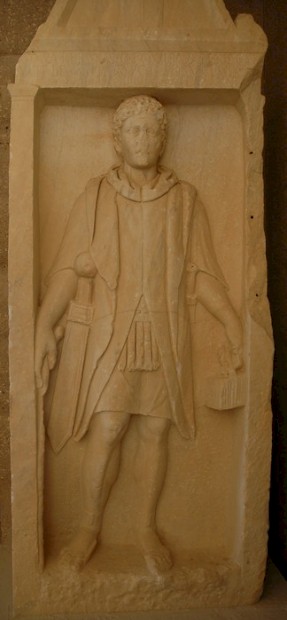
After the war at Philippi, Octavian fell out with Mark Antony's brother Lucius, who was besieged at Perugia. A sling stone mentioning a military tribune from the eighth legion attests to the unit's presence.
The Eighth must have been used in Octavian's struggle against Sextus Pompeius, who had occupied Sicily, but was expelled by Octavian's admiral Marcus Vipsanius Agrippa. It was probably also active in Octavian's second campaign against Mark Antony (Actium, 31 BCE), which culminated in Octavian's sole rule. In those years, this unit was still called VIII Gallica.note The surname Mutinensis was used only briefly. Veterans of the Actium war were settled at Forum Iulii (modern Fréjus in France), which was sometimes called after the legion, Colonia Octavorum.
Augustus
Now that Octavian - now known as Augustus - was the first emperor of Rome, he transferred the eighth legion to Tunisia. (Probably, at least a subunit was in northern Hispania and took part in the Cantabrian war.) Later, the legion was transferred to the Balkans, the soldiers must have won a victory that earned them the name Augusta. In 15 or 14 BCE, veterans of VIII Augusta and V Macedonica were sent to Phoenicia, to settle in the refounded city of Berytus, modern Beirut. (It is possible that this foundation was 15 years older and was settled with veterans from the Actium war.)
After 9 CE, the soldiers were staying near Poetovio (modern Ptuj) in Illyricum. But the unit had been there, probably, for some time already. We do not know how long. In Burnum, tiles have been found as well, also attesting to a stay in Illyricum.
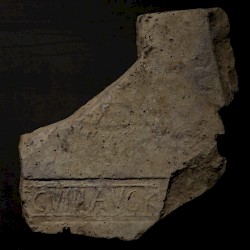 Burnum, Tile of VIII Augusta |
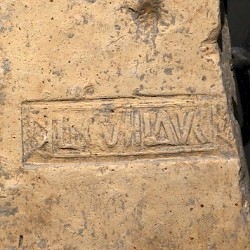 Burnum, Tile of VIII Augusta |
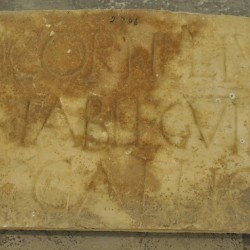 Beirut, Inscription of VIII Gallica |
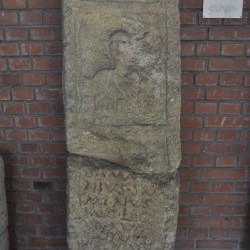 Sirmium, Inscription of Samminus, carrier of the imperial images of VIII Augusta |
In 6 CE, Augustus' son-in-law Tiberius was to lead at least eight legions (VIII Augusta and XV Apollinaris from Pannonia, XX Valeria Victrix from Illyricum, XXI Rapax from Raetia, XIII Gemina, XIV Gemina and XVI Gallica from Germania Superior and an unknown unit) against king Maroboduus of the Marcomanni in Czechia. At the same time, I Germanica, V Alaudae, XVII, XVIII and XIX were to move against Czechia as well, attacking it along the Main and Elbe. It was to be the most grandiose operation that was ever conducted by a Roman army, but a rebellion in Pannonia obstructed its execution. For the next three years, VIII Augusta was probably involved in the war against the Pannonians.
Moesia
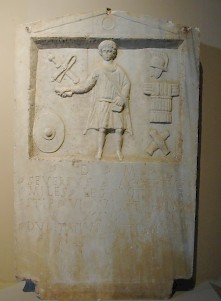
Probably in 46 or 47, the emperor Claudius moved the legionaries of the Eighth to Novae in Moesia, modern Svishtov in Bulgaria. They were replaced by soldiers of XIII Gemina. It is likely that at the same time, a subunit of VIII Augusta participated in the conquest of Britain. The tomb of Gaius Valerius Valens from Corinth dates from the period.
In 45-49, soldiers of VIII Augusta may have been employed in a war against king Mithridates of the Bosporan kingdom, i.e. the Crimea. Meanwhile, in 46, the Romans occupied Thrace, and again, legionaries of the Eighth may have been used. During the reign of the emperor Nero, the legion fought against the tribes of the Sarmatians, Dacians, and Roxolani and received the surname Bis augusta ("twice august").
In the confused year after the suicide of the emperor Nero, VIII Augusta sided with the pretender Otho and ensured his accession (January 69), but was unable to protect him against another pretender, Vitellius. Later, it supported Vespasian. Next year, the legion was with general Cerialis, who restored order in the Rhineland after the Batavian revolt.
To the Rhine
They were first stationed at Mirebeau-sur-Bèze, 25 kilometers from Dyon, but there was a second fortress at Argentoratum (modern Strasbourg) in Germania Superior. Here the legion protected a strategic crossing point of the Middle Rhine. It was to remain there for more than three centuries.
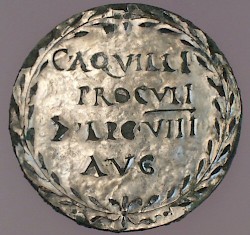
In 74, the soldiers constructed a road from Strasbourg to Rottweil and Hufingen through the Black forest, to shorten the way from the Middle Rhine to the Upper Danube. This was the beginning of the occupation of modern Baden-Württemberg (often called Agri decumates). It is almost certain that the eighth legion was part of the forces that the emperor Domitian employed (in 83/85 and 88/89) against the Chatti, who threatened the newly conquered Roman possessions in the Black Forest.
For more than a century, VIII Augusta stayed in its defensive position. Oddly enough, we know nothing about subunits that took part in Trajan's wars in Dacia, and next to nothing about soldiers fighting in the Danubian wars of Marcus Aurelius.
In 187, a man named Maternus had freed some prisoners and started a gang of robbers. Deserters from several army units joined Maternus, but the legion of Strasbourg defeated them (more...). The future emperor Pescennius Niger was also involved, propably as commander of a provincial levy from Gaul. The legion was rewarded the title Pia Fidelis Constans Commoda ("Faithful, loyal, reliable, and useful"). The last element, which reminded people of the notorious emperor Commodus, was dropped after his death in 192.
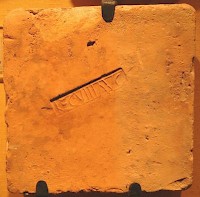
After the unlucky reign of Publius Helvius Pertinax in 193 and the coup of Didius Julianus, the legion immediately supported the countercoup of Lucius Septimius Severus, and the new emperor used it in his wars against the Parthian empire and, in 196/197, against his rival Clodius Albinus. Because the urban cohort of Lyon (cohors XIII urbana) had sided with the latter, Septimius Severus ordered a subunit of VIII Augusta to guard the capital of Gaul.
Severus' son Caracalla employed VIII Augusta, together with III Italica and XXII Primigenia, during his successful campaign against the a coalition of Germanic warriors, the Alamanni, in 213.
A generation later, Severus Alexander used the Eighth in his campaign against the Persian Sasanians (233). While so many Roman soldiers were away, the Alamanni successfully attacked Baden-Württemberg. In 235, the Romans retaliated and it is likely that VIII Augusta was one of the active units. Although Severus Alexander was killed by his own men, his successor Maximinus Thrax brought the war to a good end. An inscription from Sirmium proves that a subunit was in that city in about 260.
Late Antiquity
Between 250 and 260, however, Baden-Württemberg was seized by the Alamanni. This time, the Romans were unable to strike back and they gave up the country between Danube and Rhine. However, VIII Augusta still defended the Rhine frontier. In the conflict between the emperors Gallienus (of Italy) and Postumus (of Gaul), the legion seems to have supported the former, and it received honorific titles like V, VI, VII Pia fidelis (five times, six times, and seven times faithful and loyal). Yet, it seems certain that Postumus controlled Germania Superior, so we are left with a minor problem.
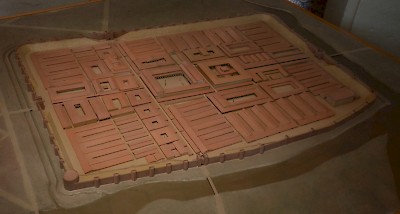
In the fourth century, a subunit of the eighth august legion occupied Divitia, modern Deutz, a castle opposite Cologne, in Germania Inferior. Other soldiers in this castle were from the Second Italian Legion.
The main force of the unit, however, was still in Strasbourg in the fourth century, perhaps with a new legion called XII Victrix. Direct evidence is rare, but an inscription found at Zurzach on the Upper Rhine and dating to 371, proves that VIII Augusta still existed and was in Germania Superior. Here it remained until the first years of the fifth century, when the supreme commander of the Roman forces in the west, Stilicho, transferred the army of the Rhine to the south, where it had to defend Italy against the Visigothic invaders.
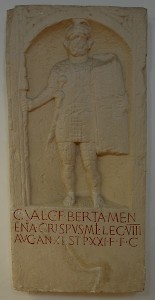
The picture to the right shows the tomb of Gaius Valerius, who served in the eighth legion Augusta for 21 years. When he died c.90 CE, he was 40 years old. Valerius was buried in the ancient spa of Wiesbaden, and it is likely that he visited this town to heal from an illness - but in vain.
Like all legions founded by Julius Caesar, this legion's emblem was a bull. It may be represented on the the monument of Köln-Alteburg, which commemorates a victory by the Rhine fleet and a legion, and can be dated to the first half of the third century.
Literature
- S. Mitchell, "Legio VIII and the garrison of Augustan Galatia", in: Classical Quarterly 26 (1976) 298-305
- M. Reddé, "Legio VIII Augusta", in: Yann Le Bohec, Les légions de Rome sous le Haut-Empire (2000 Lyon) 119-126
